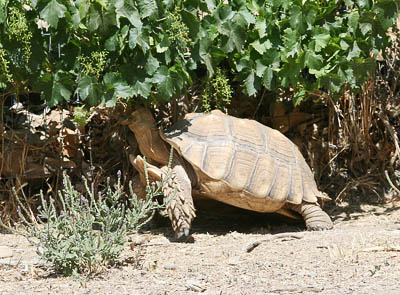
Diet Guidelines
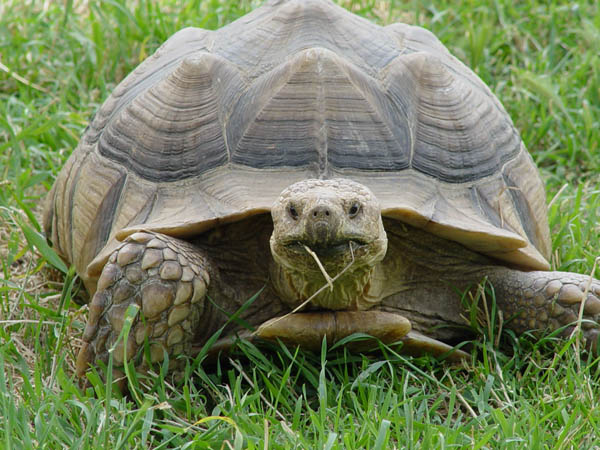
In my opinion, Bernard Devaux’s book titled The Crying Tortoise is the best book on the subject of the sulcata tortoise. The book is currently out of print and sold out. If you have access to a copy of The Crying Tortoise, read "Nutrition" (Chapter 6) on pages 59-60.
Definition of a sulcata tortoise: four-legged reptilian food disposal unit.
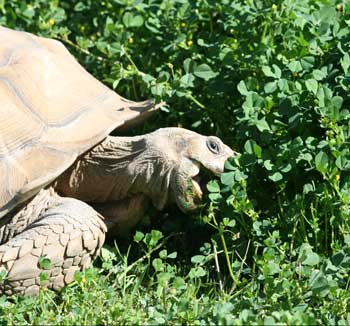 Bermuda and St. Augustine grasses are the majority of my sulcata tortoises' diet. They also get watermelon rinds, zucchini, grape and sycamore leaves, and pumpkin. Pumpkin itself is not a natural dewormer; the deworming ingredient is in the kernel of the seed.
Bermuda and St. Augustine grasses are the majority of my sulcata tortoises' diet. They also get watermelon rinds, zucchini, grape and sycamore leaves, and pumpkin. Pumpkin itself is not a natural dewormer; the deworming ingredient is in the kernel of the seed.
I have about six acres of natural weeds and grasses, including mallow, amaranth, rye, curly dock, purslane, mustard and other unidentified weeds. When I mow, I give all the mowings to the sulcata tortoises. I have one tortoise that likes common fennel and lilac leaves. I also give cactus pads (Opuntia species), and I do not scrape off the spines.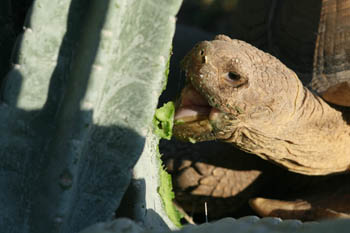
Our tortoises get very little in the way of fruit or vegetables. The reason is not that these will cause "parasite blooms." I have not found that to be true at all. The reason is that the tortoises get very little nutrition from such produce. Sulcata tortoises certainly eat a lot of fruit in the wild; remember: they are opportunistic eaters.
What about a diet of 70% hay and 30% dark leafy greens? This does not seem to be part of their natural foraging in habitat, nor can I find any research or other documentation that supports this as a proven dietary requirement. Most people, when I question them about dark leafy greens, think that means some kind of store-bought lettuces or salad greens. The reason I do not use dark leafy salad-type greens, fruits and vegetables is this: greens, fruit and vegetables do have nutrition, but they have too much water. The tortoise's fecal material passes through its gut too fast and is too wet and soft when excreted.
There are no good reasons, in my opinion, to feed grocery-store fruit or vegetables, not even as a treat. Only humans think a "treat" is a necessity of life. For a treat, try other grasses, weeds, flowers, leaves, but keep it natural, not store-bought.
 For the animal to maximize the nutrient value of the food it ingests, food should stay in the gut 48 to 72 hours, and perhaps longer, depending on the climate. If its food passes through its system more rapidly, the animal's hunger is not satisfied, and it will want to eat more and more.
For the animal to maximize the nutrient value of the food it ingests, food should stay in the gut 48 to 72 hours, and perhaps longer, depending on the climate. If its food passes through its system more rapidly, the animal's hunger is not satisfied, and it will want to eat more and more.
Long-fiber grasses, both green and dry, will stay in the gut to ferment much longer than grocery-store greens, vegetables and fruit. More nutrition is absorbed through the fermenting process. I recommend Bermuda grass, Bermuda hay, alfalfa hay (alfalfa does not have too much protein), and St. Augustine grass. I have not had good luck with feeding either Timothy hay or Orchard hay.
Observe what comes out the back end, and you will know whether or not what is going in the front end is right! Look at your tortoises' fecal samples, check the color, break them open, and smell them. Healthy fecal pellets do not have an offensive odor. Do your "poop homework."
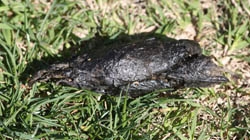 Healthy fresh fecal pellet, dry and fibrous |
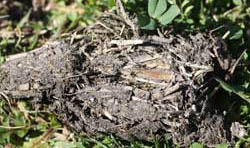 Healthy weathered fecal pellet |
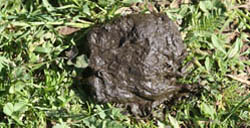 Fecal sample that is too wet and too soft from an excess of "wet" foods |
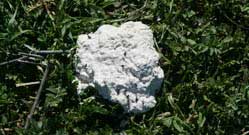 Urates, a normal "cottage-cheese" textured excretion of uric acid salts |
Note:If you must keep sulcata tortoises in a cold climate, let them cool down to about 50°F (10°C), and warm up slowly so they will eat a little later in the day. Feed them only long-fiber grasses, green or dry, because the fermenting process creates internal core heat. The animal’s core temperature will be maintained more evenly throughout the night.
I also stay away from the Brassica group of foods such as cabbage, kale, broccoli, etc., because these vegetables are gas and fart makers. Have you ever heard a sulcata tortoise burp or fart? It's pretty funny to us, but it seems uncomfortable for the animal. They, like ourselves, can develop a taste for certain favorite foods, whether or not they are nutritious food choices. Be careful not to let their diet get out of control!
Sulcata tortoises have adapted to their natural habitat, to different climates and different foods, in order to survive on what nature provided. In the wild, at the beginning of spring they will eat for many weeks. Then they stop eating to aestivate (a period of summer dormancy) without food or water for several months. During this aestivation, they are living off their reserves. They retain their urine and gut contents so long that the fecal material is almost solid like wood. See Bernard Devaux's book The Crying Tortoise, pages 60 to 62.
It is their adaptability that enables most sulcatas tortoises to do well in captivity, in spite of outdated, misdirected information and human "mothering."
